Financial Management: Exploring Concepts, Statements, and Ratio Usage
VerifiedAdded on 2023/06/15
|9
|2462
|187
Report
AI Summary
This report provides a comprehensive overview of financial management, defining its core concepts and highlighting its significance in ensuring long-term stability and informed decision-making within a business organization. It details the main financial statements, including the balance sheet and profit and loss statement, explaining their role in conveying a firm's financial performance and position. The report also explores the use of financial ratios, such as profitability and liquidity ratios, in evaluating a company's financial health and identifying areas for improvement. Through calculations and analysis, the report demonstrates how these ratios can inform strategic decisions and enhance a company's overall financial performance in a competitive market environment. Desklib offers numerous resources for students, including past papers and solved assignments.
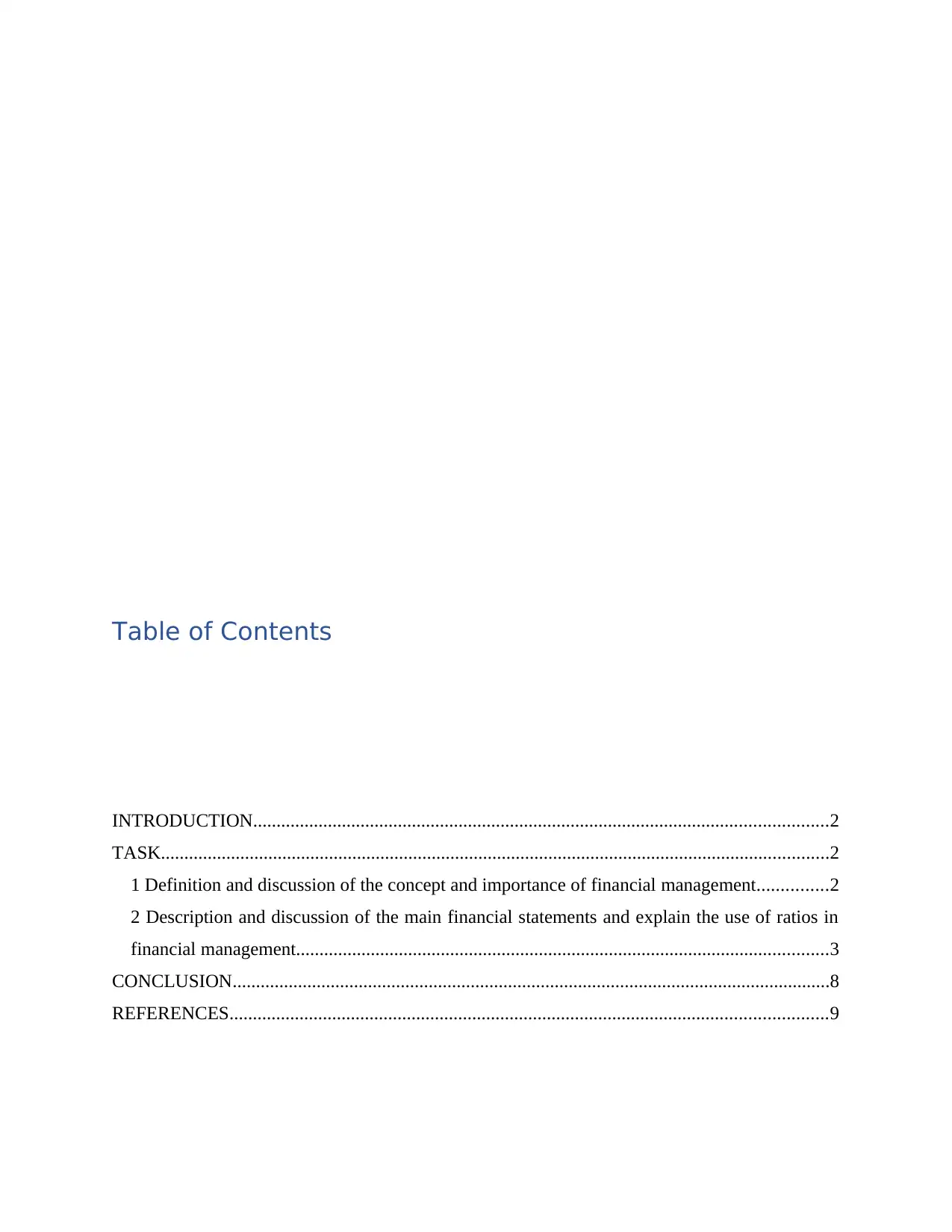
Table of Contents
INTRODUCTION...........................................................................................................................2
TASK...............................................................................................................................................2
1 Definition and discussion of the concept and importance of financial management...............2
2 Description and discussion of the main financial statements and explain the use of ratios in
financial management..................................................................................................................3
CONCLUSION................................................................................................................................8
REFERENCES................................................................................................................................9
INTRODUCTION...........................................................................................................................2
TASK...............................................................................................................................................2
1 Definition and discussion of the concept and importance of financial management...............2
2 Description and discussion of the main financial statements and explain the use of ratios in
financial management..................................................................................................................3
CONCLUSION................................................................................................................................8
REFERENCES................................................................................................................................9
Paraphrase This Document
Need a fresh take? Get an instant paraphrase of this document with our AI Paraphraser
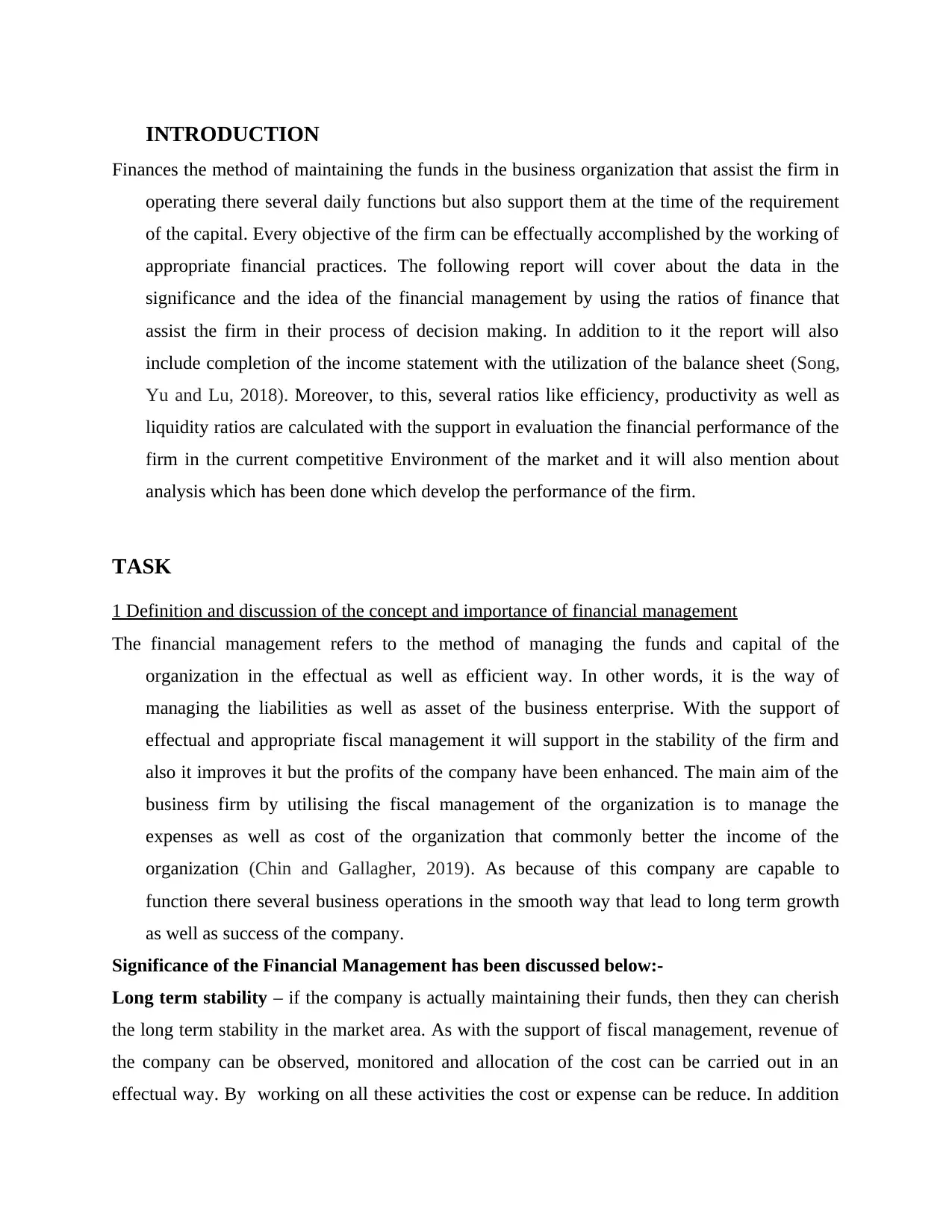
INTRODUCTION
Finances the method of maintaining the funds in the business organization that assist the firm in
operating there several daily functions but also support them at the time of the requirement
of the capital. Every objective of the firm can be effectually accomplished by the working of
appropriate financial practices. The following report will cover about the data in the
significance and the idea of the financial management by using the ratios of finance that
assist the firm in their process of decision making. In addition to it the report will also
include completion of the income statement with the utilization of the balance sheet (Song,
Yu and Lu, 2018). Moreover, to this, several ratios like efficiency, productivity as well as
liquidity ratios are calculated with the support in evaluation the financial performance of the
firm in the current competitive Environment of the market and it will also mention about
analysis which has been done which develop the performance of the firm.
TASK
1 Definition and discussion of the concept and importance of financial management
The financial management refers to the method of managing the funds and capital of the
organization in the effectual as well as efficient way. In other words, it is the way of
managing the liabilities as well as asset of the business enterprise. With the support of
effectual and appropriate fiscal management it will support in the stability of the firm and
also it improves it but the profits of the company have been enhanced. The main aim of the
business firm by utilising the fiscal management of the organization is to manage the
expenses as well as cost of the organization that commonly better the income of the
organization (Chin and Gallagher, 2019). As because of this company are capable to
function there several business operations in the smooth way that lead to long term growth
as well as success of the company.
Significance of the Financial Management has been discussed below:-
Long term stability – if the company is actually maintaining their funds, then they can cherish
the long term stability in the market area. As with the support of fiscal management, revenue of
the company can be observed, monitored and allocation of the cost can be carried out in an
effectual way. By working on all these activities the cost or expense can be reduce. In addition
Finances the method of maintaining the funds in the business organization that assist the firm in
operating there several daily functions but also support them at the time of the requirement
of the capital. Every objective of the firm can be effectually accomplished by the working of
appropriate financial practices. The following report will cover about the data in the
significance and the idea of the financial management by using the ratios of finance that
assist the firm in their process of decision making. In addition to it the report will also
include completion of the income statement with the utilization of the balance sheet (Song,
Yu and Lu, 2018). Moreover, to this, several ratios like efficiency, productivity as well as
liquidity ratios are calculated with the support in evaluation the financial performance of the
firm in the current competitive Environment of the market and it will also mention about
analysis which has been done which develop the performance of the firm.
TASK
1 Definition and discussion of the concept and importance of financial management
The financial management refers to the method of managing the funds and capital of the
organization in the effectual as well as efficient way. In other words, it is the way of
managing the liabilities as well as asset of the business enterprise. With the support of
effectual and appropriate fiscal management it will support in the stability of the firm and
also it improves it but the profits of the company have been enhanced. The main aim of the
business firm by utilising the fiscal management of the organization is to manage the
expenses as well as cost of the organization that commonly better the income of the
organization (Chin and Gallagher, 2019). As because of this company are capable to
function there several business operations in the smooth way that lead to long term growth
as well as success of the company.
Significance of the Financial Management has been discussed below:-
Long term stability – if the company is actually maintaining their funds, then they can cherish
the long term stability in the market area. As with the support of fiscal management, revenue of
the company can be observed, monitored and allocation of the cost can be carried out in an
effectual way. By working on all these activities the cost or expense can be reduce. In addition
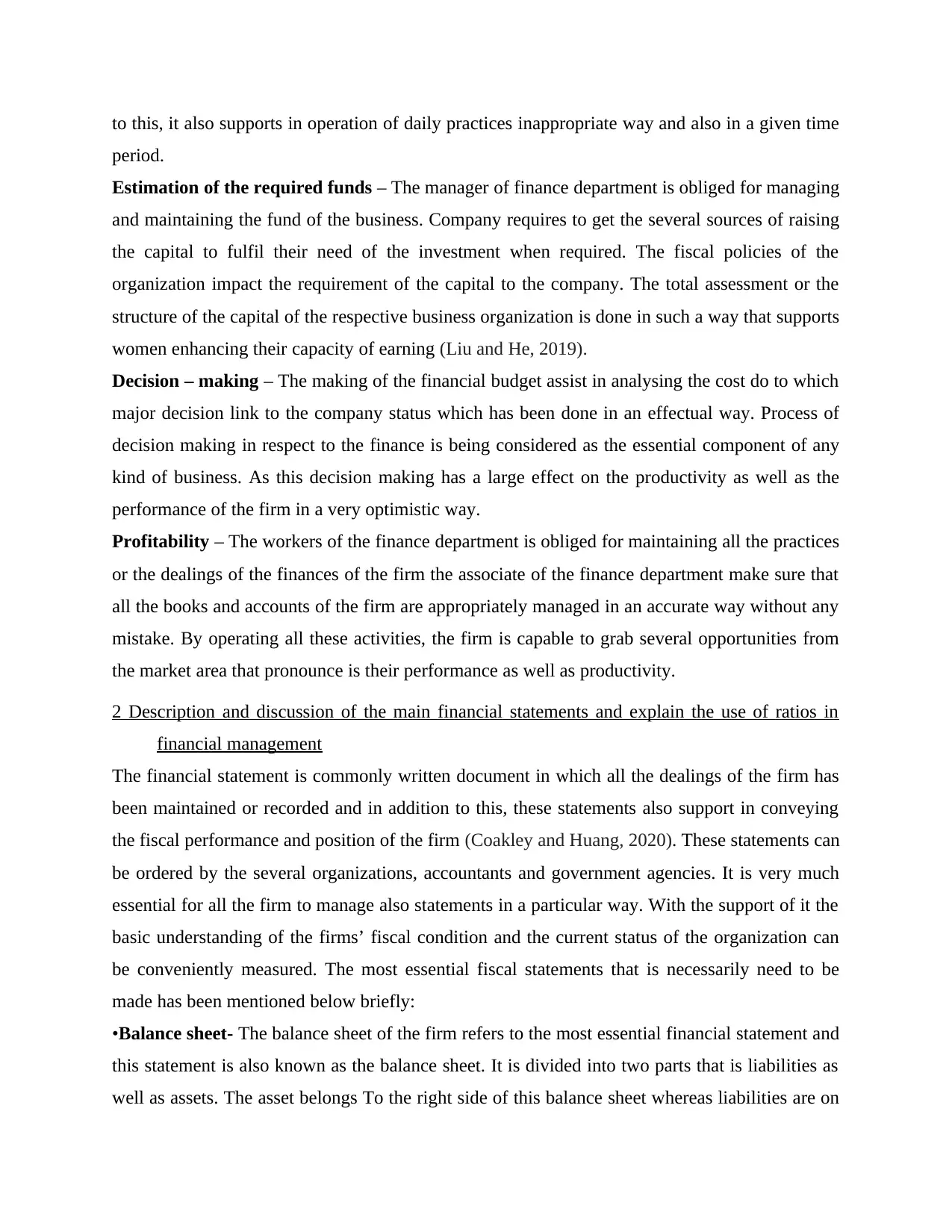
to this, it also supports in operation of daily practices inappropriate way and also in a given time
period.
Estimation of the required funds – The manager of finance department is obliged for managing
and maintaining the fund of the business. Company requires to get the several sources of raising
the capital to fulfil their need of the investment when required. The fiscal policies of the
organization impact the requirement of the capital to the company. The total assessment or the
structure of the capital of the respective business organization is done in such a way that supports
women enhancing their capacity of earning (Liu and He, 2019).
Decision – making – The making of the financial budget assist in analysing the cost do to which
major decision link to the company status which has been done in an effectual way. Process of
decision making in respect to the finance is being considered as the essential component of any
kind of business. As this decision making has a large effect on the productivity as well as the
performance of the firm in a very optimistic way.
Profitability – The workers of the finance department is obliged for maintaining all the practices
or the dealings of the finances of the firm the associate of the finance department make sure that
all the books and accounts of the firm are appropriately managed in an accurate way without any
mistake. By operating all these activities, the firm is capable to grab several opportunities from
the market area that pronounce is their performance as well as productivity.
2 Description and discussion of the main financial statements and explain the use of ratios in
financial management
The financial statement is commonly written document in which all the dealings of the firm has
been maintained or recorded and in addition to this, these statements also support in conveying
the fiscal performance and position of the firm (Coakley and Huang, 2020). These statements can
be ordered by the several organizations, accountants and government agencies. It is very much
essential for all the firm to manage also statements in a particular way. With the support of it the
basic understanding of the firms’ fiscal condition and the current status of the organization can
be conveniently measured. The most essential fiscal statements that is necessarily need to be
made has been mentioned below briefly:
•Balance sheet- The balance sheet of the firm refers to the most essential financial statement and
this statement is also known as the balance sheet. It is divided into two parts that is liabilities as
well as assets. The asset belongs To the right side of this balance sheet whereas liabilities are on
period.
Estimation of the required funds – The manager of finance department is obliged for managing
and maintaining the fund of the business. Company requires to get the several sources of raising
the capital to fulfil their need of the investment when required. The fiscal policies of the
organization impact the requirement of the capital to the company. The total assessment or the
structure of the capital of the respective business organization is done in such a way that supports
women enhancing their capacity of earning (Liu and He, 2019).
Decision – making – The making of the financial budget assist in analysing the cost do to which
major decision link to the company status which has been done in an effectual way. Process of
decision making in respect to the finance is being considered as the essential component of any
kind of business. As this decision making has a large effect on the productivity as well as the
performance of the firm in a very optimistic way.
Profitability – The workers of the finance department is obliged for maintaining all the practices
or the dealings of the finances of the firm the associate of the finance department make sure that
all the books and accounts of the firm are appropriately managed in an accurate way without any
mistake. By operating all these activities, the firm is capable to grab several opportunities from
the market area that pronounce is their performance as well as productivity.
2 Description and discussion of the main financial statements and explain the use of ratios in
financial management
The financial statement is commonly written document in which all the dealings of the firm has
been maintained or recorded and in addition to this, these statements also support in conveying
the fiscal performance and position of the firm (Coakley and Huang, 2020). These statements can
be ordered by the several organizations, accountants and government agencies. It is very much
essential for all the firm to manage also statements in a particular way. With the support of it the
basic understanding of the firms’ fiscal condition and the current status of the organization can
be conveniently measured. The most essential fiscal statements that is necessarily need to be
made has been mentioned below briefly:
•Balance sheet- The balance sheet of the firm refers to the most essential financial statement and
this statement is also known as the balance sheet. It is divided into two parts that is liabilities as
well as assets. The asset belongs To the right side of this balance sheet whereas liabilities are on
⊘ This is a preview!⊘
Do you want full access?
Subscribe today to unlock all pages.

Trusted by 1+ million students worldwide
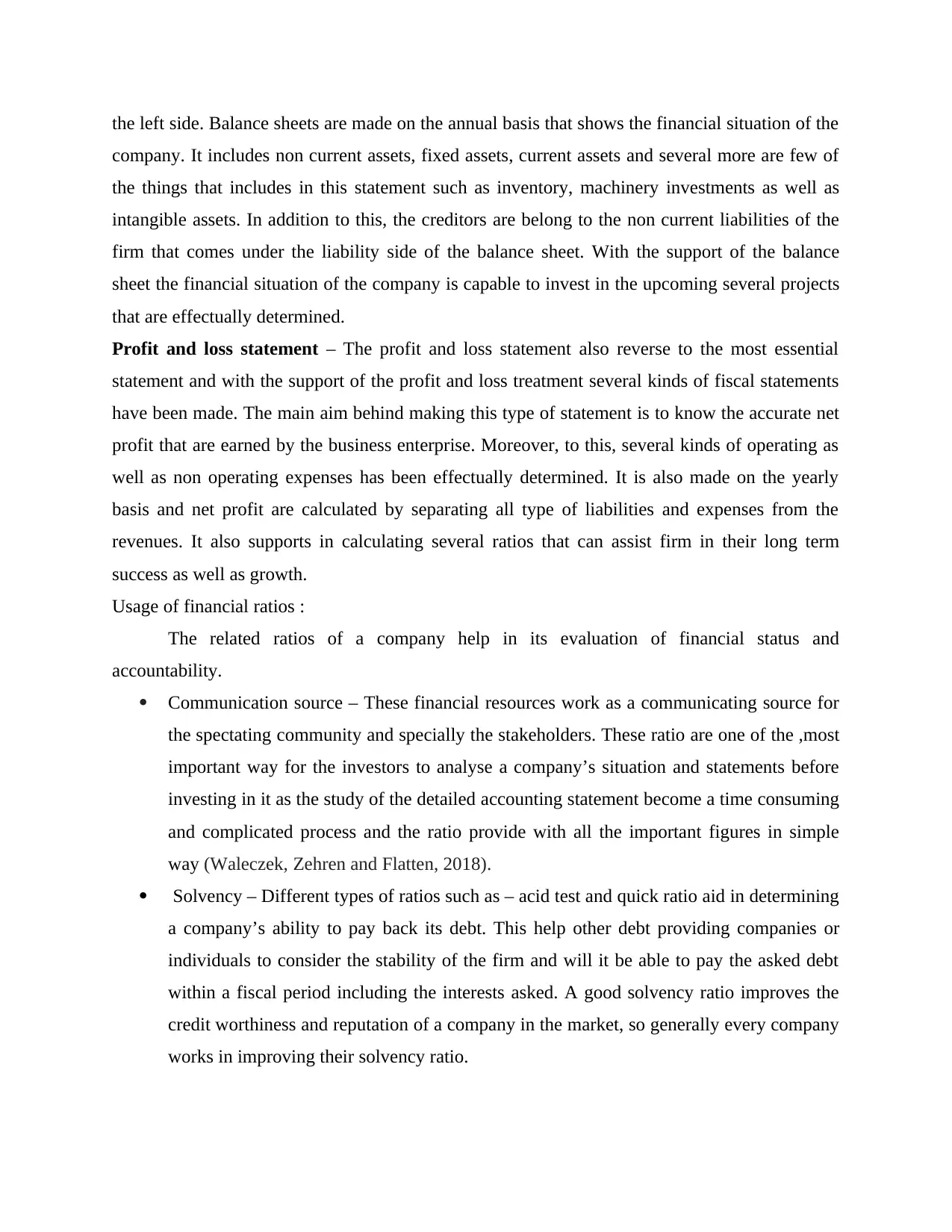
the left side. Balance sheets are made on the annual basis that shows the financial situation of the
company. It includes non current assets, fixed assets, current assets and several more are few of
the things that includes in this statement such as inventory, machinery investments as well as
intangible assets. In addition to this, the creditors are belong to the non current liabilities of the
firm that comes under the liability side of the balance sheet. With the support of the balance
sheet the financial situation of the company is capable to invest in the upcoming several projects
that are effectually determined.
Profit and loss statement – The profit and loss statement also reverse to the most essential
statement and with the support of the profit and loss treatment several kinds of fiscal statements
have been made. The main aim behind making this type of statement is to know the accurate net
profit that are earned by the business enterprise. Moreover, to this, several kinds of operating as
well as non operating expenses has been effectually determined. It is also made on the yearly
basis and net profit are calculated by separating all type of liabilities and expenses from the
revenues. It also supports in calculating several ratios that can assist firm in their long term
success as well as growth.
Usage of financial ratios :
The related ratios of a company help in its evaluation of financial status and
accountability.
Communication source – These financial resources work as a communicating source for
the spectating community and specially the stakeholders. These ratio are one of the ,most
important way for the investors to analyse a company’s situation and statements before
investing in it as the study of the detailed accounting statement become a time consuming
and complicated process and the ratio provide with all the important figures in simple
way (Waleczek, Zehren and Flatten, 2018).
Solvency – Different types of ratios such as – acid test and quick ratio aid in determining
a company’s ability to pay back its debt. This help other debt providing companies or
individuals to consider the stability of the firm and will it be able to pay the asked debt
within a fiscal period including the interests asked. A good solvency ratio improves the
credit worthiness and reputation of a company in the market, so generally every company
works in improving their solvency ratio.
company. It includes non current assets, fixed assets, current assets and several more are few of
the things that includes in this statement such as inventory, machinery investments as well as
intangible assets. In addition to this, the creditors are belong to the non current liabilities of the
firm that comes under the liability side of the balance sheet. With the support of the balance
sheet the financial situation of the company is capable to invest in the upcoming several projects
that are effectually determined.
Profit and loss statement – The profit and loss statement also reverse to the most essential
statement and with the support of the profit and loss treatment several kinds of fiscal statements
have been made. The main aim behind making this type of statement is to know the accurate net
profit that are earned by the business enterprise. Moreover, to this, several kinds of operating as
well as non operating expenses has been effectually determined. It is also made on the yearly
basis and net profit are calculated by separating all type of liabilities and expenses from the
revenues. It also supports in calculating several ratios that can assist firm in their long term
success as well as growth.
Usage of financial ratios :
The related ratios of a company help in its evaluation of financial status and
accountability.
Communication source – These financial resources work as a communicating source for
the spectating community and specially the stakeholders. These ratio are one of the ,most
important way for the investors to analyse a company’s situation and statements before
investing in it as the study of the detailed accounting statement become a time consuming
and complicated process and the ratio provide with all the important figures in simple
way (Waleczek, Zehren and Flatten, 2018).
Solvency – Different types of ratios such as – acid test and quick ratio aid in determining
a company’s ability to pay back its debt. This help other debt providing companies or
individuals to consider the stability of the firm and will it be able to pay the asked debt
within a fiscal period including the interests asked. A good solvency ratio improves the
credit worthiness and reputation of a company in the market, so generally every company
works in improving their solvency ratio.
Paraphrase This Document
Need a fresh take? Get an instant paraphrase of this document with our AI Paraphraser
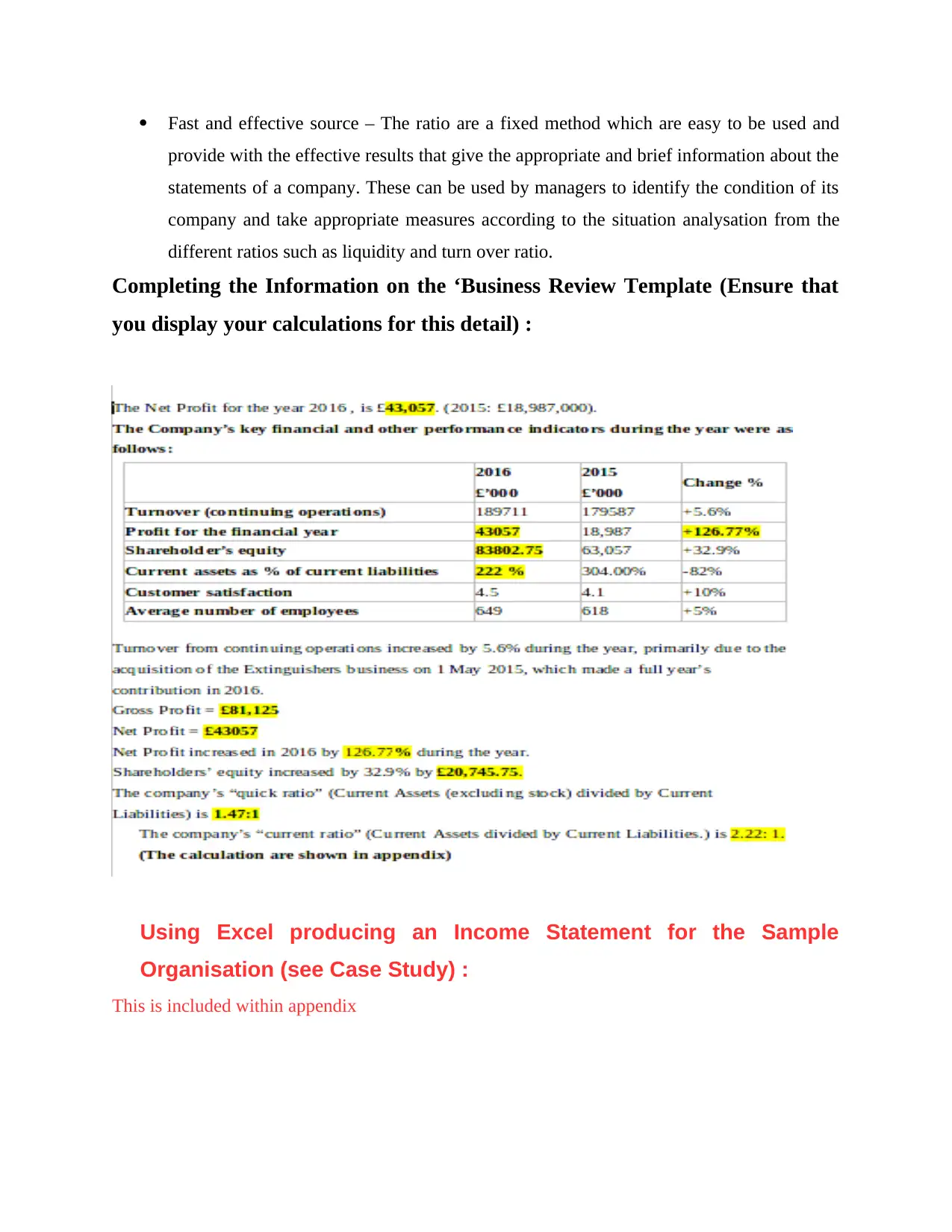
Fast and effective source – The ratio are a fixed method which are easy to be used and
provide with the effective results that give the appropriate and brief information about the
statements of a company. These can be used by managers to identify the condition of its
company and take appropriate measures according to the situation analysation from the
different ratios such as liquidity and turn over ratio.
Completing the Information on the ‘Business Review Template (Ensure that
you display your calculations for this detail) :
Using Excel producing an Income Statement for the Sample
Organisation (see Case Study) :
This is included within appendix
provide with the effective results that give the appropriate and brief information about the
statements of a company. These can be used by managers to identify the condition of its
company and take appropriate measures according to the situation analysation from the
different ratios such as liquidity and turn over ratio.
Completing the Information on the ‘Business Review Template (Ensure that
you display your calculations for this detail) :
Using Excel producing an Income Statement for the Sample
Organisation (see Case Study) :
This is included within appendix
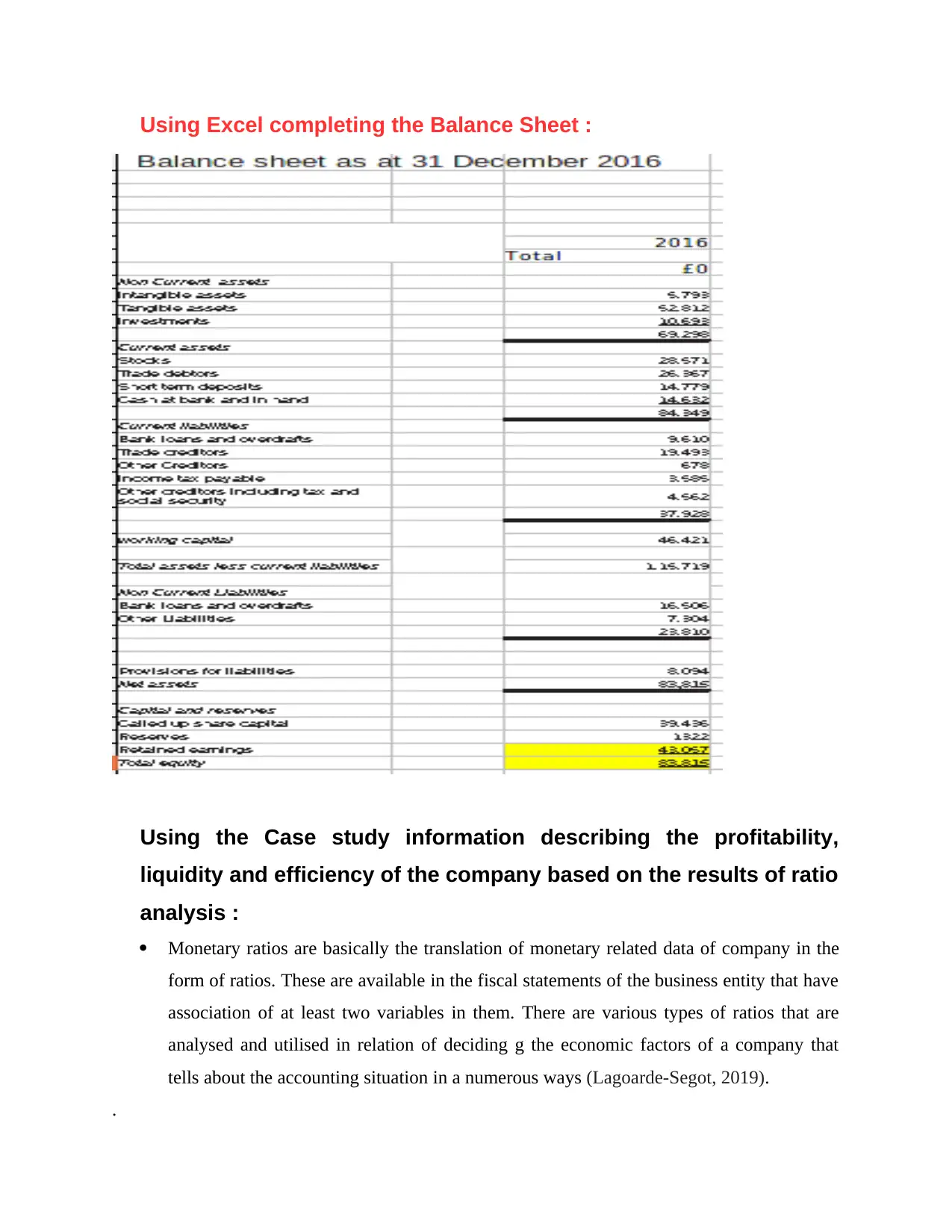
Using Excel completing the Balance Sheet :
Using the Case study information describing the profitability,
liquidity and efficiency of the company based on the results of ratio
analysis :
Monetary ratios are basically the translation of monetary related data of company in the
form of ratios. These are available in the fiscal statements of the business entity that have
association of at least two variables in them. There are various types of ratios that are
analysed and utilised in relation of deciding g the economic factors of a company that
tells about the accounting situation in a numerous ways (Lagoarde-Segot, 2019).
.
Using the Case study information describing the profitability,
liquidity and efficiency of the company based on the results of ratio
analysis :
Monetary ratios are basically the translation of monetary related data of company in the
form of ratios. These are available in the fiscal statements of the business entity that have
association of at least two variables in them. There are various types of ratios that are
analysed and utilised in relation of deciding g the economic factors of a company that
tells about the accounting situation in a numerous ways (Lagoarde-Segot, 2019).
.
⊘ This is a preview!⊘
Do you want full access?
Subscribe today to unlock all pages.

Trusted by 1+ million students worldwide
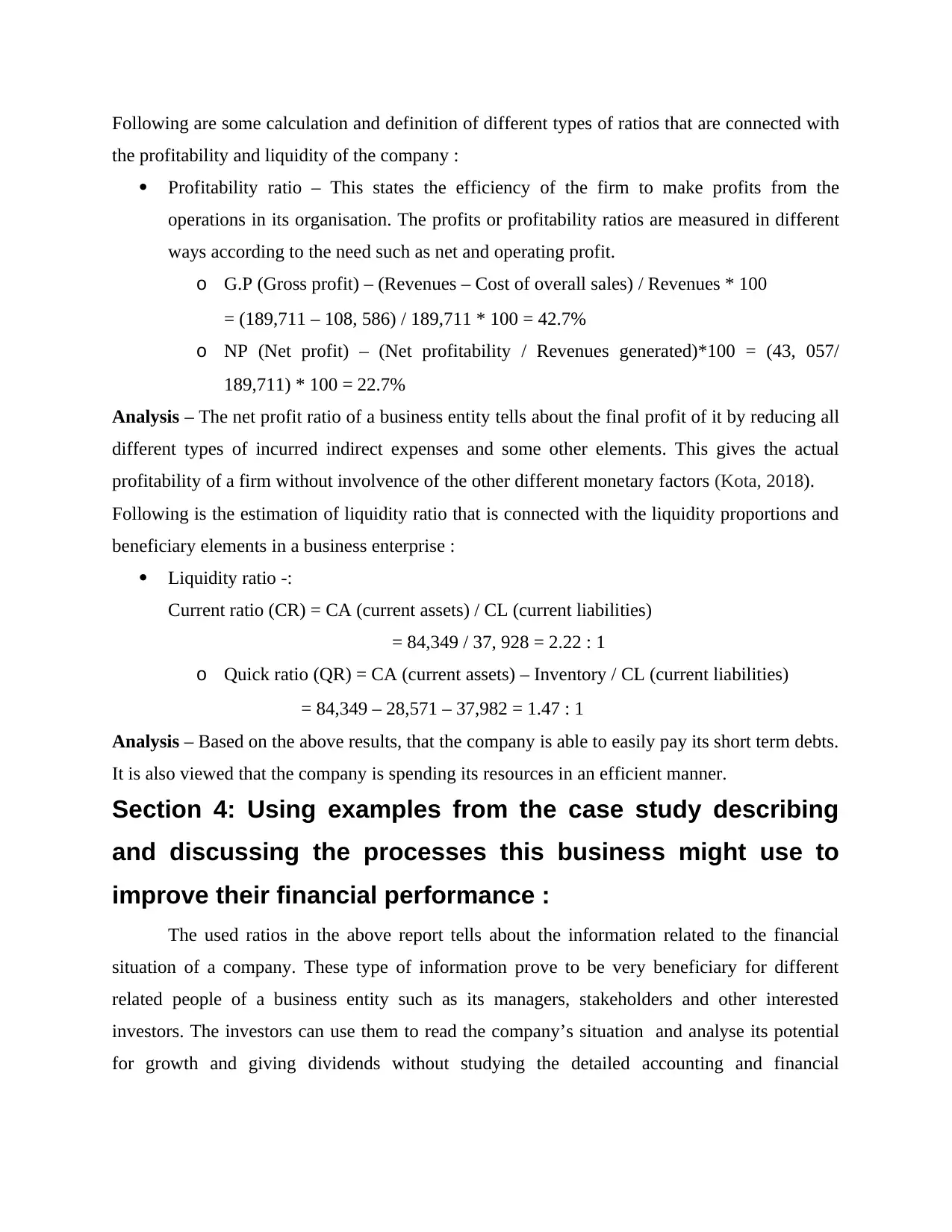
Following are some calculation and definition of different types of ratios that are connected with
the profitability and liquidity of the company :
Profitability ratio – This states the efficiency of the firm to make profits from the
operations in its organisation. The profits or profitability ratios are measured in different
ways according to the need such as net and operating profit.
o G.P (Gross profit) – (Revenues – Cost of overall sales) / Revenues * 100
= (189,711 – 108, 586) / 189,711 * 100 = 42.7%
o NP (Net profit) – (Net profitability / Revenues generated)*100 = (43, 057/
189,711) * 100 = 22.7%
Analysis – The net profit ratio of a business entity tells about the final profit of it by reducing all
different types of incurred indirect expenses and some other elements. This gives the actual
profitability of a firm without involvence of the other different monetary factors (Kota, 2018).
Following is the estimation of liquidity ratio that is connected with the liquidity proportions and
beneficiary elements in a business enterprise :
Liquidity ratio -:
Current ratio (CR) = CA (current assets) / CL (current liabilities)
= 84,349 / 37, 928 = 2.22 : 1
o Quick ratio (QR) = CA (current assets) – Inventory / CL (current liabilities)
= 84,349 – 28,571 – 37,982 = 1.47 : 1
Analysis – Based on the above results, that the company is able to easily pay its short term debts.
It is also viewed that the company is spending its resources in an efficient manner.
Section 4: Using examples from the case study describing
and discussing the processes this business might use to
improve their financial performance :
The used ratios in the above report tells about the information related to the financial
situation of a company. These type of information prove to be very beneficiary for different
related people of a business entity such as its managers, stakeholders and other interested
investors. The investors can use them to read the company’s situation and analyse its potential
for growth and giving dividends without studying the detailed accounting and financial
the profitability and liquidity of the company :
Profitability ratio – This states the efficiency of the firm to make profits from the
operations in its organisation. The profits or profitability ratios are measured in different
ways according to the need such as net and operating profit.
o G.P (Gross profit) – (Revenues – Cost of overall sales) / Revenues * 100
= (189,711 – 108, 586) / 189,711 * 100 = 42.7%
o NP (Net profit) – (Net profitability / Revenues generated)*100 = (43, 057/
189,711) * 100 = 22.7%
Analysis – The net profit ratio of a business entity tells about the final profit of it by reducing all
different types of incurred indirect expenses and some other elements. This gives the actual
profitability of a firm without involvence of the other different monetary factors (Kota, 2018).
Following is the estimation of liquidity ratio that is connected with the liquidity proportions and
beneficiary elements in a business enterprise :
Liquidity ratio -:
Current ratio (CR) = CA (current assets) / CL (current liabilities)
= 84,349 / 37, 928 = 2.22 : 1
o Quick ratio (QR) = CA (current assets) – Inventory / CL (current liabilities)
= 84,349 – 28,571 – 37,982 = 1.47 : 1
Analysis – Based on the above results, that the company is able to easily pay its short term debts.
It is also viewed that the company is spending its resources in an efficient manner.
Section 4: Using examples from the case study describing
and discussing the processes this business might use to
improve their financial performance :
The used ratios in the above report tells about the information related to the financial
situation of a company. These type of information prove to be very beneficiary for different
related people of a business entity such as its managers, stakeholders and other interested
investors. The investors can use them to read the company’s situation and analyse its potential
for growth and giving dividends without studying the detailed accounting and financial
Paraphrase This Document
Need a fresh take? Get an instant paraphrase of this document with our AI Paraphraser
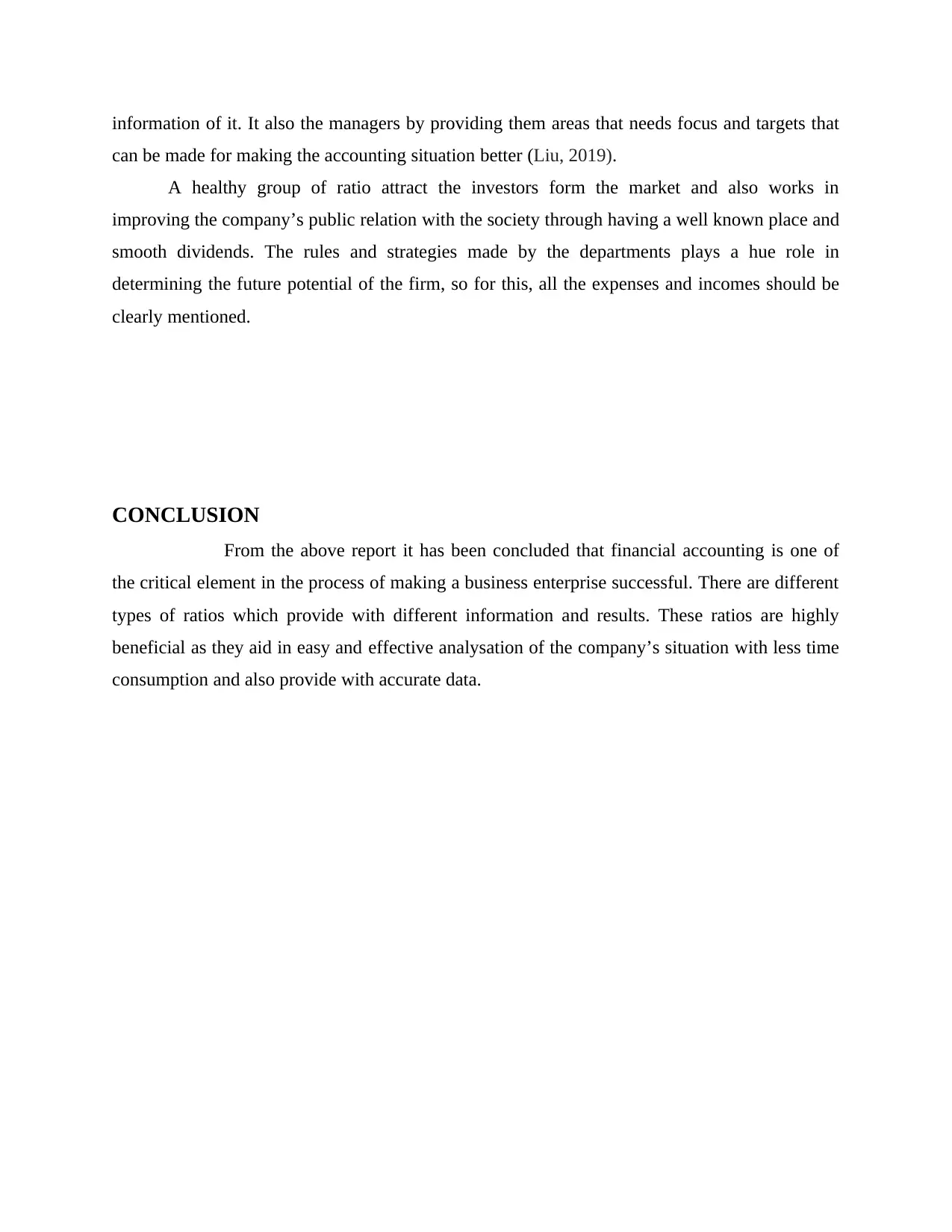
information of it. It also the managers by providing them areas that needs focus and targets that
can be made for making the accounting situation better (Liu, 2019).
A healthy group of ratio attract the investors form the market and also works in
improving the company’s public relation with the society through having a well known place and
smooth dividends. The rules and strategies made by the departments plays a hue role in
determining the future potential of the firm, so for this, all the expenses and incomes should be
clearly mentioned.
CONCLUSION
From the above report it has been concluded that financial accounting is one of
the critical element in the process of making a business enterprise successful. There are different
types of ratios which provide with different information and results. These ratios are highly
beneficial as they aid in easy and effective analysation of the company’s situation with less time
consumption and also provide with accurate data.
can be made for making the accounting situation better (Liu, 2019).
A healthy group of ratio attract the investors form the market and also works in
improving the company’s public relation with the society through having a well known place and
smooth dividends. The rules and strategies made by the departments plays a hue role in
determining the future potential of the firm, so for this, all the expenses and incomes should be
clearly mentioned.
CONCLUSION
From the above report it has been concluded that financial accounting is one of
the critical element in the process of making a business enterprise successful. There are different
types of ratios which provide with different information and results. These ratios are highly
beneficial as they aid in easy and effective analysation of the company’s situation with less time
consumption and also provide with accurate data.
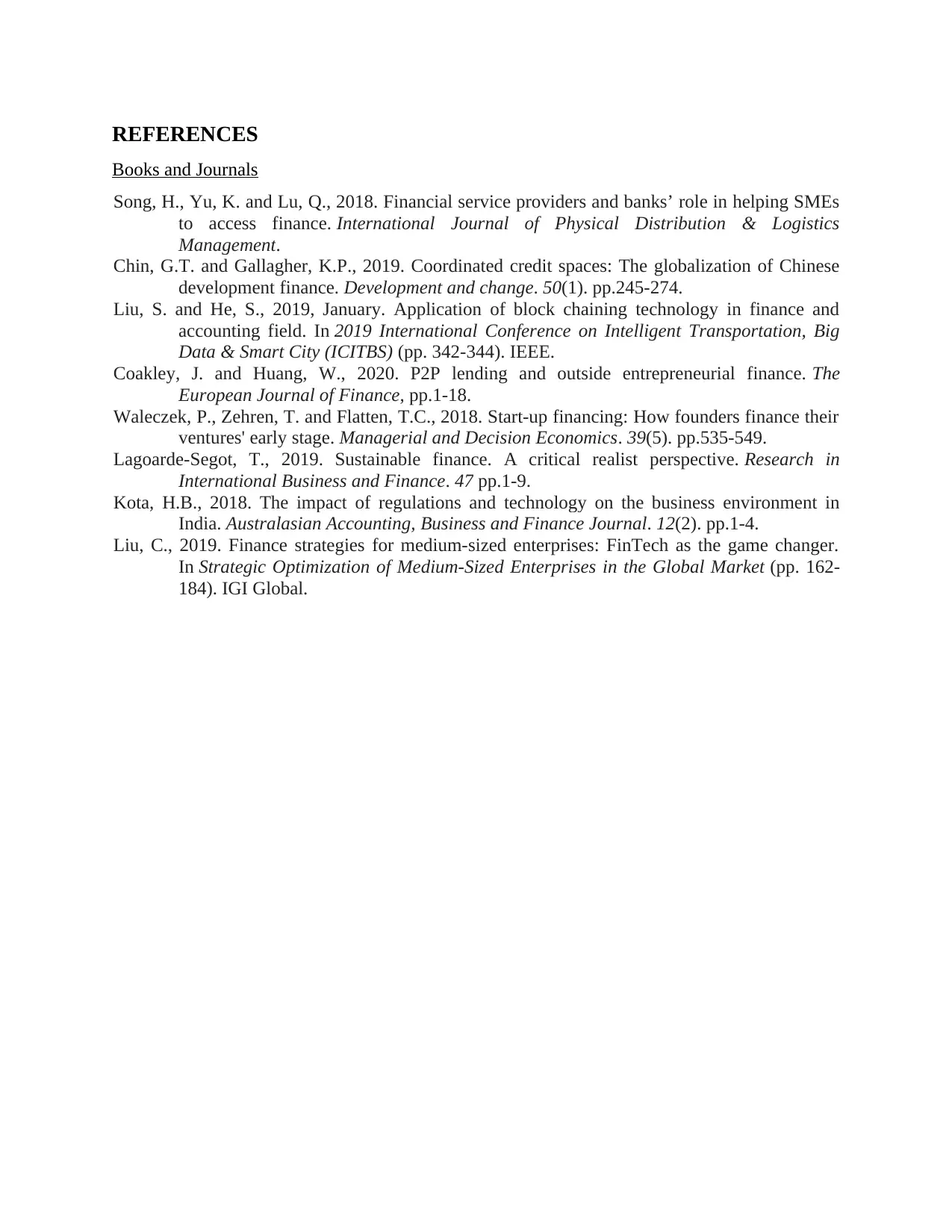
REFERENCES
Books and Journals
Song, H., Yu, K. and Lu, Q., 2018. Financial service providers and banks’ role in helping SMEs
to access finance. International Journal of Physical Distribution & Logistics
Management.
Chin, G.T. and Gallagher, K.P., 2019. Coordinated credit spaces: The globalization of Chinese
development finance. Development and change. 50(1). pp.245-274.
Liu, S. and He, S., 2019, January. Application of block chaining technology in finance and
accounting field. In 2019 International Conference on Intelligent Transportation, Big
Data & Smart City (ICITBS) (pp. 342-344). IEEE.
Coakley, J. and Huang, W., 2020. P2P lending and outside entrepreneurial finance. The
European Journal of Finance, pp.1-18.
Waleczek, P., Zehren, T. and Flatten, T.C., 2018. Start‐up financing: How founders finance their
ventures' early stage. Managerial and Decision Economics. 39(5). pp.535-549.
Lagoarde-Segot, T., 2019. Sustainable finance. A critical realist perspective. Research in
International Business and Finance. 47 pp.1-9.
Kota, H.B., 2018. The impact of regulations and technology on the business environment in
India. Australasian Accounting, Business and Finance Journal. 12(2). pp.1-4.
Liu, C., 2019. Finance strategies for medium-sized enterprises: FinTech as the game changer.
In Strategic Optimization of Medium-Sized Enterprises in the Global Market (pp. 162-
184). IGI Global.
Books and Journals
Song, H., Yu, K. and Lu, Q., 2018. Financial service providers and banks’ role in helping SMEs
to access finance. International Journal of Physical Distribution & Logistics
Management.
Chin, G.T. and Gallagher, K.P., 2019. Coordinated credit spaces: The globalization of Chinese
development finance. Development and change. 50(1). pp.245-274.
Liu, S. and He, S., 2019, January. Application of block chaining technology in finance and
accounting field. In 2019 International Conference on Intelligent Transportation, Big
Data & Smart City (ICITBS) (pp. 342-344). IEEE.
Coakley, J. and Huang, W., 2020. P2P lending and outside entrepreneurial finance. The
European Journal of Finance, pp.1-18.
Waleczek, P., Zehren, T. and Flatten, T.C., 2018. Start‐up financing: How founders finance their
ventures' early stage. Managerial and Decision Economics. 39(5). pp.535-549.
Lagoarde-Segot, T., 2019. Sustainable finance. A critical realist perspective. Research in
International Business and Finance. 47 pp.1-9.
Kota, H.B., 2018. The impact of regulations and technology on the business environment in
India. Australasian Accounting, Business and Finance Journal. 12(2). pp.1-4.
Liu, C., 2019. Finance strategies for medium-sized enterprises: FinTech as the game changer.
In Strategic Optimization of Medium-Sized Enterprises in the Global Market (pp. 162-
184). IGI Global.
⊘ This is a preview!⊘
Do you want full access?
Subscribe today to unlock all pages.

Trusted by 1+ million students worldwide
1 out of 9
Related Documents
Your All-in-One AI-Powered Toolkit for Academic Success.
+13062052269
info@desklib.com
Available 24*7 on WhatsApp / Email
![[object Object]](/_next/static/media/star-bottom.7253800d.svg)
Unlock your academic potential
Copyright © 2020–2025 A2Z Services. All Rights Reserved. Developed and managed by ZUCOL.


